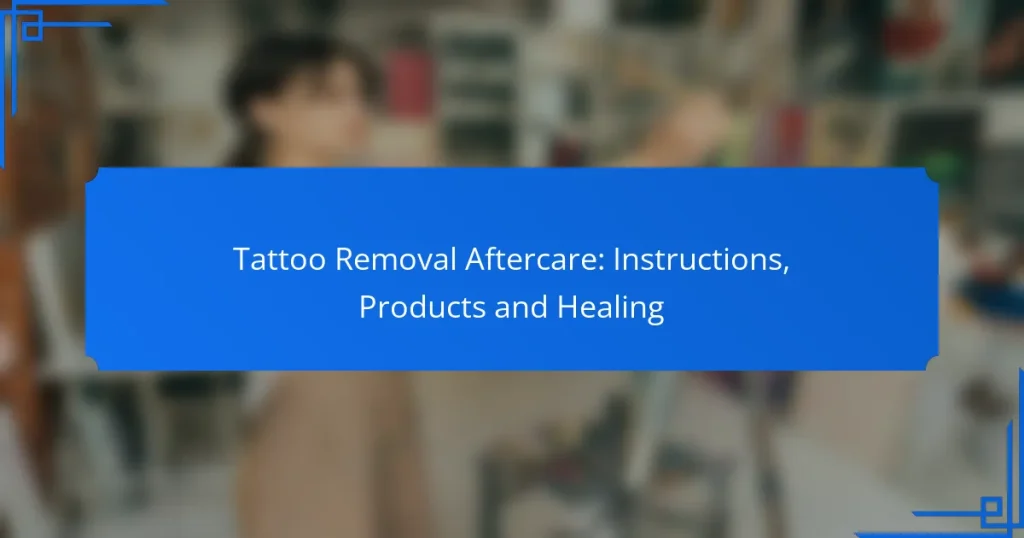Effective tattoo removal aftercare is crucial for optimal healing and results. By following specific instructions and using the right products, you can minimize discomfort and prevent complications during recovery. Understanding the healing process and utilizing recommended aftercare products will help ensure your skin heals properly and efficiently.

What Are the Best Tattoo Removal Aftercare Instructions?
Effective tattoo removal aftercare is crucial for optimal healing and results. Following specific instructions can help minimize discomfort and prevent complications during the recovery process.
Keep the area clean
Maintaining cleanliness is essential for preventing infections during the healing of the treated area. Gently wash the skin with mild soap and lukewarm water twice daily, avoiding harsh scrubs or abrasive materials.
After washing, pat the area dry with a clean towel. Ensure that the towel is soft and does not irritate the skin. Keeping the area clean helps promote healing and reduces the risk of scarring.
Avoid sun exposure
Protecting the treated area from sun exposure is vital for proper healing. UV rays can cause irritation and increase the risk of pigmentation changes in the skin.
For at least a few weeks post-treatment, wear protective clothing or apply a broad-spectrum sunscreen with a high SPF when going outdoors. This will help shield the area from harmful rays and support the healing process.
Moisturize regularly
Regular moisturizing is important to keep the skin hydrated and promote healing. Use a fragrance-free, gentle moisturizer recommended by your practitioner.
Apply the moisturizer several times a day, especially after washing the area. This helps to soothe the skin, reduce dryness, and prevent scabbing.
Do not pick at scabs
It is crucial to avoid picking at any scabs that form during the healing process. Picking can lead to scarring and may increase the risk of infection.
If scabs do form, allow them to fall off naturally. Keeping the area moisturized can help minimize scabbing and promote smoother healing.
Follow up with your practitioner
Regular follow-up appointments with your tattoo removal practitioner are essential for monitoring healing progress. These visits allow your practitioner to assess the treated area and address any concerns.
During follow-ups, your practitioner can provide additional care instructions and determine if further treatments are necessary. Staying in communication helps ensure the best possible outcome for your tattoo removal process.

Which Products Are Recommended for Tattoo Removal Aftercare?
For effective tattoo removal aftercare, it’s essential to use products that promote healing and protect the skin. Recommended products include hydrating ointments, antibacterial creams, sunblock specifically formulated for healing skin, and specialized aftercare kits.
Hydrating ointments
Hydrating ointments are crucial for maintaining moisture in the treated area, which helps prevent scabbing and promotes healing. Look for ointments that contain ingredients like aloe vera or vitamin E, as they soothe the skin and enhance recovery.
Apply a thin layer of hydrating ointment several times a day, especially after washing the area. Avoid over-applying, as this can clog pores and lead to irritation.
Antibacterial creams
Antibacterial creams help prevent infections during the healing process, which is vital after tattoo removal. Choose creams that contain ingredients like bacitracin or neomycin, which are effective against common skin bacteria.
Apply a small amount of antibacterial cream to the area after cleaning it. Use this product for the first week or until the skin has healed sufficiently, but avoid using it for extended periods to prevent skin irritation.
Sunblock for healing skin
Sunblock is essential for protecting healing skin from UV damage, which can lead to discoloration and prolonged healing. Use a broad-spectrum sunscreen with an SPF of at least 30, and ensure it is suitable for sensitive skin.
Apply sunblock generously before going outdoors, and reapply every two hours, especially if sweating or swimming. This protection is crucial for several months post-treatment to ensure optimal healing.
Specific aftercare kits
Specific aftercare kits designed for tattoo removal often include a combination of hydrating ointments, antibacterial creams, and sunblock, tailored for optimal healing. These kits can simplify the aftercare process by providing all necessary products in one package.
When selecting an aftercare kit, check for reputable brands and read reviews to ensure the products are effective and safe for your skin type. Following the instructions provided with the kit will help maximize the healing process and improve results.

How Long Does the Healing Process Take?
The healing process for tattoo removal typically spans several weeks to months, depending on various factors such as the individual’s skin type, the size of the treated area, and the method used for removal. Understanding the stages of healing can help you manage expectations and care for your skin effectively.
Initial healing period
The initial healing period usually lasts about 1 to 2 weeks. During this time, the treated area may appear red, swollen, or blistered, which is a normal response as the skin begins to heal. It’s crucial to keep the area clean and moisturized to prevent infection.
After the first few days, you may notice scabbing or peeling, which is part of the natural healing process. Avoid picking at the scabs, as this can lead to scarring or infection.
Full recovery timeline
Full recovery from tattoo removal can take anywhere from 4 to 12 weeks, depending on the individual’s skin and the extent of the treatment. During this period, the skin will gradually return to its normal appearance, and any residual redness should fade.
To support healing, continue to avoid sun exposure and harsh chemicals on the treated area. Regular follow-ups with your practitioner can help monitor the healing process and address any concerns that may arise.

What Are Common Mistakes in Tattoo Removal Aftercare?
Common mistakes in tattoo removal aftercare can hinder the healing process and lead to complications. Proper care is essential to ensure effective healing and minimize the risk of infection or scarring.
Neglecting hygiene
Maintaining hygiene is critical during tattoo removal aftercare. Failing to keep the area clean can introduce bacteria, increasing the risk of infection. Wash the treated area gently with mild soap and water before applying any aftercare products.
It’s advisable to wash your hands thoroughly before touching the treated area. Avoid submerging the area in water, such as in baths or swimming pools, for at least a week to prevent contamination.
Using harsh products
Using harsh or irritating products can damage the skin and delay healing. Avoid alcohol-based solutions, strong exfoliants, or any products containing fragrances, as these can cause irritation and inflammation.
Instead, opt for gentle, fragrance-free moisturizers or ointments recommended by your tattoo removal specialist. Always perform a patch test on a small skin area before applying any new product to the treated site.
Ignoring signs of infection
Recognizing signs of infection is crucial for effective aftercare. Symptoms such as increased redness, swelling, pus, or a fever may indicate an infection that requires prompt medical attention.
If you notice any of these symptoms, contact your healthcare provider immediately. Early intervention can prevent more severe complications and ensure proper healing of the treated area.

What Should You Expect During the Healing Process?
During the healing process after tattoo removal, you can expect a range of sensations and changes in the treated area. Initially, the skin may be red, swollen, and tender, but these symptoms typically subside within a few days as the skin begins to heal.
Initial Reactions
Right after the tattoo removal procedure, the skin may exhibit redness and swelling. This is a normal response as your body reacts to the treatment. You might also experience some discomfort or a burning sensation, similar to a mild sunburn.
To manage these initial reactions, applying a cold compress can help reduce swelling and soothe the area. Keep the treated skin clean and avoid any harsh products that could irritate it further.
Healing Timeline
The healing timeline can vary, but most individuals notice significant improvement within 2 to 4 weeks. Initially, the skin may scab or peel as it heals, which is a natural part of the recovery process.
It’s essential to avoid picking at scabs or peeling skin, as this can lead to scarring or infection. Following proper aftercare instructions will help ensure a smoother healing experience.
Signs of Complications
While most healing processes are straightforward, be aware of signs of complications. If you notice excessive redness, swelling that worsens, or discharge that is yellow or green, these could indicate an infection.
In such cases, it’s crucial to consult with your healthcare provider promptly. Early intervention can prevent more severe issues and promote better healing outcomes.

